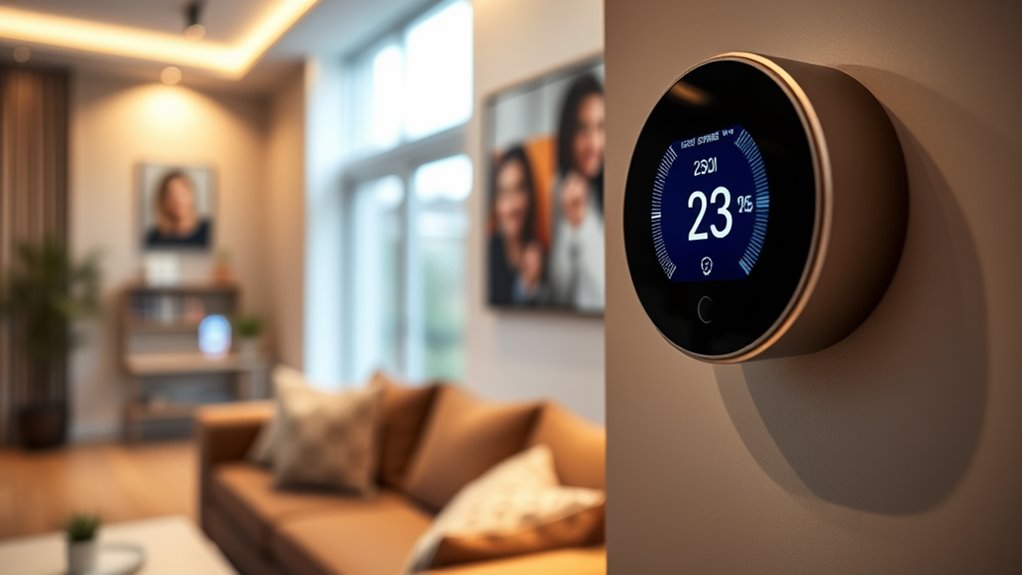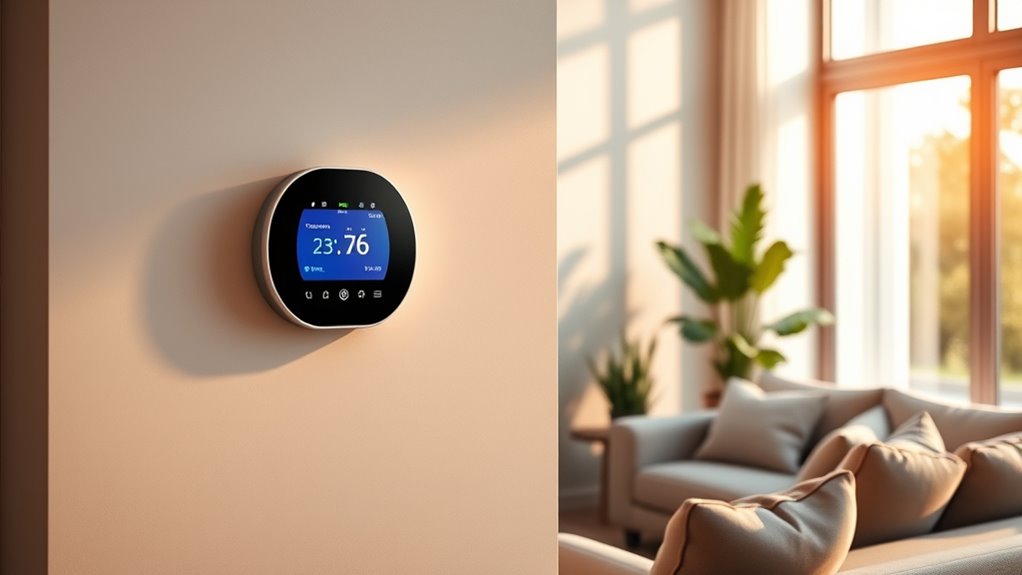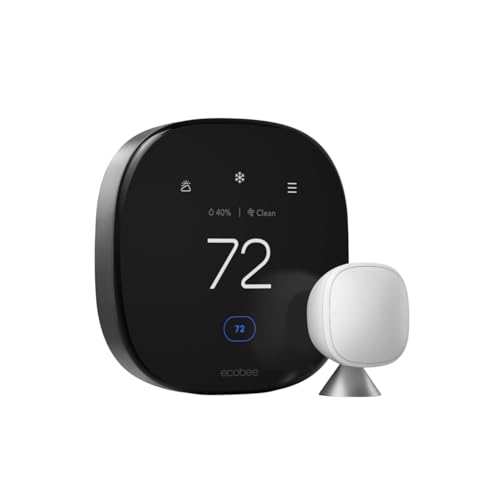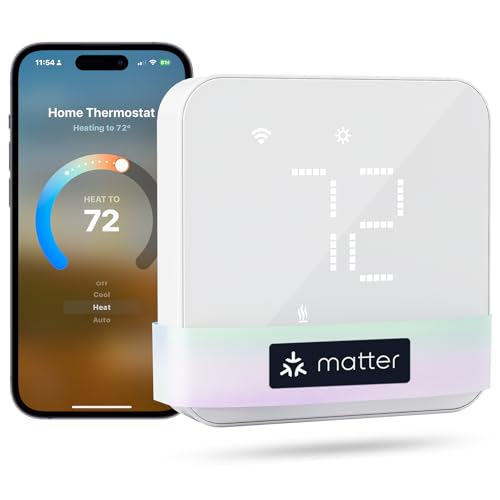If you’re looking to upgrade to smarter home comfort in 2025, I recommend exploring the top 15 thermostats like ecobee’s premium models, Nest Learning, and Sensi Touch. These devices offer compatibility with various HVAC systems, easy DIY installation, and remote control via smartphones or voice assistants. Many are ENERGY STAR certified and include advanced features like air quality monitoring and energy reports. Keep going, and I’ll guide you through the best options to suit your needs.
Key Takeaways
- Compatibility with various HVAC systems, including heat pumps and radiant boilers, ensures versatile smart home integration.
- Easy DIY installation with app guidance and Wi-Fi remote control enhances user convenience.
- Advanced features like energy monitoring, scheduling, and voice assistant compatibility optimize home comfort and efficiency.
- ENERGY STAR-certified models offer significant energy savings and potential utility rebates in 2025.
- User-friendly designs with sleek interfaces and smart sensors improve overall home automation and user experience.
Amazon Smart Thermostat
If you’re looking for an affordable yet reliable smart thermostat that easily upgrades your home’s energy efficiency, the Amazon Smart Thermostat is an excellent choice. Released in 2021, it works with most 24V HVAC systems, including heat pumps and radiant boilers, though it’s not suitable for 110-240V systems. It’s made with Honeywell technology, backed by 130 years of experience, and is ENERGY STAR certified, saving you around $50 annually. With Alexa integration, on-device controls, and app management, it’s simple to use and set up. Plus, its automation features, like presence detection and scheduling, help optimize comfort and savings effortlessly.
Best For: homeowners seeking an affordable, easy-to-install smart thermostat compatible with most 24V HVAC systems and integrated with Alexa for automated control.
Pros:
- Compatible with a wide range of 24V HVAC systems, including heat pumps and radiant boilers
- ENERGY STAR certified, providing energy savings of approximately $50 annually
- Supports automation features like scheduling, presence detection, and remote control via Alexa app or voice commands
Cons:
- Not suitable for 110-240V systems like electric baseboard heating
- Some users experience connectivity issues or app stability problems, especially on Android devices
- Installation may require wiring knowledge, particularly for homes without a C-wire or with split systems
ecobee Smart Thermostat Essential – Wi-Fi Programmable Thermostat
The ecobee Smart Thermostat Essential stands out as an excellent choice for homeowners seeking energy savings without sacrificing convenience. It can save up to 23% annually on heating and cooling costs by customizing schedules that automatically adjust temperatures when you’re away or home. You can easily track your energy use remotely through the ecobee app, with software updates ensuring it stays optimized. Compatible with 85% of HVAC systems, including gas, electric, and heat pumps, it requires no C-wire thanks to the Power Extender Kit. Its color touchscreen and smart home integrations with Alexa, Google, and Apple make controlling your home effortless.
Best For: homeowners seeking an easy-to-install, energy-efficient smart thermostat compatible with most HVAC systems and integrated with major smart home platforms.
Pros:
- Saves up to 23% annually on heating and cooling costs through personalized scheduling and energy monitoring.
- Compatible with 85% of HVAC systems, including gas, electric, and heat pumps, with no C-wire needed when using the Power Extender Kit.
- Features a user-friendly color touchscreen and seamless integration with Apple HomeKit, Google Assistant, and Amazon Alexa for remote control and voice commands.
Cons:
- May require a Power Extender Kit for homes without a C-wire, which could involve additional installation steps.
- Limited to Wi-Fi connectivity, so internet outages can temporarily affect remote control functions.
- Some advanced features or integrations might require the latest app updates or subscriptions, depending on the smart home ecosystem.
Sensi Smart Thermostat
The Sensi Smart Thermostat (Model ST55) stands out for its ease of installation and compatibility, making it an ideal choice for DIY enthusiasts seeking a seamless upgrade. Its simple setup uses a built-in level and step-by-step app instructions, often eliminating the need for a common wire. Designed to resemble traditional thermostats, it fits easily into existing wall space without patching or painting. With Wi-Fi connectivity, mobile app control, and Alexa compatibility, it offers convenient remote access and scheduling. Additionally, being ENERGY STAR certified, it helps save around 23% on HVAC energy costs, all while prioritizing your privacy and security.
Best For: DIY homeowners seeking an easy-to-install, compatible, and energy-efficient smart thermostat with remote control capabilities.
Pros:
- Simple DIY installation with built-in level and step-by-step app guidance
- Compatible with most HVAC systems, often eliminating the need for a c-wire
- ENERGY STAR certified, helping save approximately 23% on energy costs
Cons:
- May not be compatible with very complex or specialized HVAC systems
- Limited advanced customization features compared to some high-end smart thermostats
- Reliance on Wi-Fi and app control, which may be less convenient for users preferring physical controls
ecobee Smart Thermostat Enhanced, Programmable WiFi Thermostat
For homeowners seeking an energy-efficient and easy-to-install smart thermostat, the ecobee Smart Thermostat Enhanced stands out with its built-in Power Extender Kit, which eliminates the need for a C-wire. It helps conserve up to 26% annually on heating and cooling costs by automatically adjusting temperatures when you’re away and preheating or precooling before you arrive. It also maintains comfort during sleep and routines while factoring in humidity for a consistent environment. Compatible with Siri, Alexa, Google Assistant, and most HVAC systems, it offers remote control via the ecobee app. Its hardwired design ensures reliability, making it a versatile choice for smarter, more efficient homes.
Best For: homeowners looking for an energy-efficient, easy-to-install smart thermostat compatible with various HVAC systems and smart home platforms.
Pros:
- Energy savings of up to 26% annually on heating and cooling costs.
- Easy installation with included Power Extender Kit and compatibility with most HVAC systems.
- Seamless integration with Siri, Alexa, Google Assistant, and remote control via the ecobee app.
Cons:
- May require professional installation for optimal setup in complex systems.
- Limited to 24 VAC HVAC systems; not compatible with all system types.
- Additional SmartSensor required for optimal room-specific comfort, which is an extra purchase.
ecobee Smart Thermostat Premium with Sensors and Air Quality Monitor
If you’re looking to optimize both comfort and safety in your home, the ecobee Smart Thermostat Premium with Sensors and Air Quality Monitor stands out as an excellent choice. It can save you up to 26% annually on heating and cooling costs, thanks to ENERGY STAR certification and smart sensors that target key rooms, reducing hot and cold spots. The built-in air quality monitor alerts you to poor conditions, reminds you to change filters, and detects smoke or sudden temperature drops for added safety. Plus, it acts as a home security hub with occupancy sensing and alerts for open windows or doors, helping you stay protected and energy-efficient.
Best For: homeowners seeking to enhance energy efficiency, air quality, and security with a smart, user-friendly thermostat system.
Pros:
- Saves up to 26% annually on heating and cooling costs with ENERGY STAR certification.
- Integrates air quality monitoring, safety alerts, and occupancy sensing for comprehensive home management.
- Supports voice control via Siri and Alexa, and works with popular smart home platforms for seamless integration.
Cons:
- Requires a subscription to ecobee Smart Security for full security features.
- Compatibility limited to most 24VAC HVAC systems; some complex or proprietary systems may not be supported.
- Advanced setup and integration may be challenging for users unfamiliar with smart home technology.
Google Nest Thermostat, Programmable WiFi Thermostat
The Google Nest Thermostat stands out as an ideal choice for homeowners seeking energy savings without sacrificing comfort. It’s ENERGY STAR certified and compatible with most heating and cooling systems, even those without a C wire. With dual-band Wi-Fi and Bluetooth, you can control it remotely via your smartphone or tablet, adjusting settings on the go. The thermostat learns your routines, automatically adjusts when you’re away, and offers the Savings Finder feature to optimize energy use. It also monitors your HVAC system’s health and sends maintenance alerts, helping extend system life. This smart thermostat combines convenience, efficiency, and system care in one sleek device.
Best For: homeowners seeking an energy-efficient, easy-to-control smart thermostat compatible with a wide range of HVAC systems, including those without a C wire.
Pros:
- ENERGY STAR certified, promoting energy savings and environmental friendliness
- Remote control capability via Wi-Fi and Bluetooth for convenience
- Monitors HVAC health and provides maintenance alerts to extend system lifespan
Cons:
- No lock feature to prevent unauthorized adjustments
- Compatibility may require checking with the Nest Compatibility Checker for certain systems
- Some HVAC setups, such as heating-only or zone-controlled systems, may need additional wiring or accessories
Like-New Amazon Smart Thermostat
Opting for a like-new Amazon Smart Thermostat is an excellent choice for budget-conscious homeowners who want reliable energy savings without sacrificing quality. These refurbished units are tested, certified, and come with the same limited warranty as new devices. ENERGY STAR certified, they can save around $50 annually on energy bills. Easy to install via the Alexa app in about 15-20 minutes, they work with most 24V HVAC systems. Features include voice control, schedule programming, and automatic adjustments based on routines or phone location. While some users face initial setup issues, overall, these thermostats offer a cost-effective, eco-friendly way to enhance home comfort and efficiency.
Best For: budget-conscious homeowners seeking reliable, energy-efficient smart thermostat control that is easy to install and use.
Pros:
- Certified energy savings with ENERGY STAR, potentially saving around $50 annually
- Easy 15-20 minute installation via the Alexa app, compatible with most 24V HVAC systems
- Offers convenient voice control, scheduling, and automatic adjustments for enhanced home comfort
Cons:
- May experience initial setup or app recognition issues reported by some users
- No support for 110-240V systems such as electric baseboard heat
- Lacks room sensors, limiting advanced zoning capabilities
Sensi Lite Smart Thermostat
For homeowners seeking a budget-friendly yet reliable smart thermostat, the Sensi Lite Smart Thermostat stands out with its Wi-Fi connectivity and easy DIY installation. It works with Alexa and offers programmable scheduling, helping you customize comfort effortlessly. Most systems don’t need a C-wire, making installation straightforward, especially for standard HVAC setups. As an Energy Star Certified device, it can reduce HVAC energy costs by around 23%, saving you money while increasing efficiency. Plus, it supports remote control via a user-friendly app on Android and iOS, giving you convenient access to manage your home’s temperature from anywhere, anytime.
Best For: homeowners seeking an affordable, easy-to-install smart thermostat that offers reliable energy savings and remote control capabilities.
Pros:
- Easy DIY installation with step-by-step guidance and built-in level
- Compatible with most HVAC systems, with no C-wire required for standard setups
- Energy Star Certified, helping reduce HVAC costs by approximately 23%
Cons:
- May require a C-wire for heat pump and heat/cool systems
- Limited advanced customization features compared to higher-end smart thermostats
- Does not support advanced smart home integrations beyond Alexa
EMERSON Sensi Touch Wi-Fi Smart Thermostat
If you’re looking for a smart thermostat that combines user-friendly design with robust compatibility, the Emerson Sensi Touch Wi-Fi Smart Thermostat stands out as an excellent choice. It features a vibrant touchscreen display, works seamlessly with Alexa, Google Assistant, Apple HomeKit, and SmartThings. Easy to install, it typically takes less than 30 minutes and doesn’t require extra patching. The thermostat helps cut energy costs by around 23% through flexible scheduling and remote control via the Sensi app. Plus, it offers smart maintenance alerts, performance monitoring, and supports humidity levels up to 90%, making it a versatile addition to any smart home.
Best For: homeowners seeking an easy-to-install, energy-efficient smart thermostat with broad compatibility and user-friendly features.
Pros:
- Compatible with Alexa, Google Assistant, Apple HomeKit, and Samsung SmartThings for seamless smart home integration
- Easy installation in less than 30 minutes without extra patching needed
- Helps reduce energy costs by approximately 23% with flexible scheduling and remote control via the Sensi app
Cons:
- Requires a C-wire for installation, which may not be available in all homes
- Limited to non-condensing humidity support up to 90%, which may not suit all environments
- Basic design may lack advanced customization features found in higher-end thermostats
Honeywell Home Smart Thermostat with WiFi
The Honeywell Home Smart Thermostat with WiFi stands out for its seamless integration with popular smart home platforms like Amazon Alexa, Google Assistant, and Apple HomeKit, thanks to its Matter certification. It allows remote control via the First Alert app and offers energy management features like demand response. You can customize schedules, enable auto-away for savings, and monitor indoor humidity. The thermostat also provides change air filter reminders and a low-heat setpoint extension to 32°F. Energy Star certified, it promotes efficiency and rebates. Keep in mind, it requires a C-wire for installation, and a power adapter may be necessary for proper operation.
Best For: homeowners seeking a versatile, energy-efficient smart thermostat compatible with multiple smart home platforms and remote control capabilities.
Pros:
- Seamless integration with Amazon Alexa, Google Assistant, and Apple HomeKit via Matter certification
- Customizable scheduling, auto-away, and humidity monitoring features for personalized comfort
- Energy Star certified, supporting energy savings and rebate opportunities
Cons:
- Requires a C-wire for installation, which may necessitate additional wiring or adapters
- May need a C-wire power adapter for proper operation in some setups
- Non-programmable options are limited, and setup complexity can vary depending on existing wiring
RTH9585WF1004 Wi-Fi Smart Color Thermostat
The RTH9585WF1004 Wi-Fi Smart Color Thermostat stands out with its customizable color touchscreen, making it ideal for homeowners who want both style and smart control. I love how I can personalize the background to match my decor and access local weather and forecasts directly on the screen. It supports various systems like forced air, hot water, steam, and heat pumps, though it doesn’t work with electric baseboard heat. The device connects seamlessly to Wi-Fi, allowing me to control it remotely via app or voice with Alexa. Its intuitive interface and energy-saving features make it a practical, stylish addition to any smart home.
Best For: homeowners seeking a customizable, energy-efficient smart thermostat with remote control and sleek design.
Pros:
- Customizable color touchscreen for personalized décor matching and easy navigation
- Supports a wide range of heating and cooling systems, including forced air, hot water, steam, and heat pumps
- Seamless Wi-Fi connectivity allows remote management via app or voice control with Alexa
Cons:
- Delicate wire connectors may be challenging to work with during installation
- Does not support electric baseboard heating (120-240V)
- Some users report lag or inconsistencies in humidity readings compared to other sensors
Google Nest Thermostat, Programmable Wi-Fi Smart Thermostat
Designed for homeowners seeking energy efficiency and convenience, the Google Nest Thermostat stands out with its Wi-Fi connectivity that lets you control your heating and cooling remotely. It’s ENERGY STAR certified and compatible with most systems, even without a C wire in many cases. You can adjust your home’s temperature from your phone, laptop, or tablet, and it works seamlessly with Google Assistant, Matter voice assistants, and smart home platforms. It automatically reduces energy use when you leave, and the Google Home app lets you set efficient schedules. Plus, it monitors your HVAC for issues, alerting you to problems and helping prevent costly repairs.
Best For: homeowners seeking an energy-efficient, easy-to-control smart thermostat that integrates seamlessly with their smart home systems and offers remote access and monitoring.
Pros:
- Compatible with most heating, cooling, zone controlled, and heat pump systems, often without needing a C wire
- Provides remote control via Wi-Fi using phones, tablets, or laptops, and works with Google Assistant and Matter voice assistants
- Includes HVAC monitoring, alerts for system issues, and maintenance reminders to prevent costly repairs
Cons:
- Some systems may still require a C wire or additional power accessories for full functionality
- No lock feature to restrict temperature adjustments by others
- Requires a compatible smart home ecosystem for voice control and advanced features
Emerson Sensi Touch Wi-Fi Smart Thermostat
If you’re seeking a smart thermostat that combines sleek design with easy DIY installation, the Emerson Sensi Touch Wi-Fi Smart Thermostat is an excellent choice. It features a large 4.3-inch color touchscreen available in black, white, and silver, making it both stylish and user-friendly. The setup includes a built-in level and step-by-step app guidance, supporting compatibility with many HVAC systems and voice assistants like Alexa and Google Assistant. With Energy Star certification, it promotes about 23% energy savings through flexible scheduling and remote control. Its intuitive interface, remote access via app, and reliable performance make it a smart upgrade for any home.
Best For: homeowners seeking a stylish, easy-to-install smart thermostat with reliable remote control and energy-saving features.
Pros:
- Sleek, modern design with a large 4.3-inch color touchscreen for easy operation
- Compatible with a wide range of HVAC systems and voice assistants like Alexa and Google Assistant
- Supports energy savings of approximately 23% through flexible scheduling and remote access
Cons:
- Initial setup may present calibration and connectivity challenges for some users
- Requires a common C-wire for power, which may not be available in all installations
- Some users have experienced minor issues with system compatibility and app responsiveness
meross Smart WiFi Thermostat with Matter, Alexa, Apple Home & Google Assistant Compatibility
For homeowners seeking a versatile, easy-to-integrate smart thermostat, the meross Smart WiFi Thermostat stands out thanks to its compatibility with Matter, Alexa, Apple Home, and Google Assistant. It works with 95% of HVAC systems, including traditional heating, heat pumps, and heating-only setups—just skip electric baseboard heaters. You’ll need a C-wire or the meross adapter for installation. It supports 2.4GHz Wi-Fi and offers customizable schedules that keep your home comfortable even without Wi-Fi. With voice control and seamless platform integration, you can manage your home remotely via the app, helping you save energy and stay connected effortlessly.
Best For: homeowners seeking a versatile, easy-to-integrate smart thermostat compatible with major smart home platforms and capable of managing most HVAC systems.
Pros:
- Compatible with Matter, Alexa, Apple Home, and Google Assistant for seamless smart home integration
- Supports customizable schedules for energy efficiency and comfort, even without Wi-Fi
- Remote control via mobile app provides convenience and on-the-go management
Cons:
- Not compatible with electric baseboard heaters
- Requires a C-wire or the meross adapter for installation
- Supports only 2.4GHz Wi-Fi networks, which may limit connectivity options for some users
RTH8800WF2022 T5 WiFi Smart Thermostat
The Honeywell RTH8800WF2022 T5 WiFi Smart Thermostat stands out as an excellent choice for homeowners seeking reliable energy savings and easy remote control. I appreciate its 7-day programmable schedule, touchscreen interface, and compatibility with Alexa, Google Assistant, and Apple HomeKit. Its geofencing and auto home/away modes optimize comfort and efficiency, helping reduce heating and cooling costs by up to 16%. The ENERGY STAR certification confirms its efficiency, while features like energy reports and utility rebate options encourage savings. Though setup can be tricky for some, its sleek design and remote access make it a practical, cost-effective upgrade for smarter home climate control.
Best For: homeowners seeking an easy-to-use, energy-efficient smart thermostat compatible with major voice assistants and customizable scheduling.
Pros:
- Easy remote control via Wi-Fi using smartphone or tablet
- ENERGY STAR certified for energy savings and environmental benefits
- Features geofencing and auto home/away modes for optimized comfort and efficiency
Cons:
- Setup can be challenging for some users, especially with compatibility checks
- Occasional connectivity and app issues reported by users
- Smart features like adaptive recovery may override manual settings, causing frustration
Factors to Consider When Choosing Smart Thermostats

When choosing a smart thermostat, I consider how well it works with my existing HVAC system and how easy it is to install. I also look for one that integrates smoothly with my smart home devices and offers clear, simple controls. Most importantly, I weigh its potential to save energy and reduce costs over time.
Compatibility With HVAC Systems
Choosing a smart thermostat that works seamlessly with your HVAC system starts with verifying compatibility. First, check if your system’s voltage and type match the thermostat’s requirements—whether it’s a 24V system or electric baseboards, for example. Some thermostats are designed for specific setups like heating-only, cooling-only, or heat pumps, so ensure yours fits. Also, confirm if your HVAC system needs a C-wire for power or if a power extender kit can do the job, especially in wireless models. It’s essential to verify the control type—forced air, radiant, or dual fuel—to ensure proper functioning. To avoid issues, use manufacturer tools or consult HVAC professionals to double-check that your chosen thermostat supports your specific system model and configuration.
Ease of Installation
Most smart thermostats are designed for easy DIY installation, often coming with step-by-step instructions that simplify wiring and setup. The process usually takes between 15 to 60 minutes, depending on your system’s complexity and your familiarity with wiring. Compatibility with your existing HVAC wiring, especially the presence of a C-wire, plays a big role in how straightforward the installation will be. Many models include built-in levels and clear terminal labels, which help ensure accurate wiring and proper placement. Using the tools provided and following the manufacturer’s guidance can substantially reduce wiring errors and installation delays. Overall, most users find that with a little patience, installing a smart thermostat isn’t too challenging, making it a doable upgrade for DIY enthusiasts and homeowners alike.
Smart Home Integration
Integrating a smart thermostat into your existing home setup can substantially enhance convenience and automation. To do that effectively, ensure the thermostat is compatible with your current smart home ecosystem, like Alexa, Google Assistant, Apple HomeKit, or SmartThings. Support for popular platforms via Wi-Fi or Matter protocol allows for seamless control across devices. Check if it can be managed through your preferred app or voice assistant—you’ll want remote access and voice commands for added ease. Automation features like geofencing, scheduling, or triggers based on other devices can boost responsiveness. Lastly, verify it can integrate with sensors and security systems to create a cohesive, automated environment. Proper integration guarantees your smart thermostat functions harmoniously with your home’s existing smart tech.
Energy Savings Potential
Energy savings potential is a key factor to contemplate when selecting a smart thermostat, as it directly affects your long-term costs and environmental impact. Many models can save you 23-26% annually on heating and cooling by optimizing schedules and adjusting temperatures automatically. Features like geofencing and occupancy detection help cut energy waste by altering settings when no one’s home or during certain times. Utility rebate programs and demand response initiatives often support these savings through financial incentives, making efficiency more affordable. Monitoring tools and usage reports allow me to analyze patterns and fine-tune settings for maximum savings. However, proper installation and configuration are vital to access the full energy-saving potential of your smart thermostat and guarantee consistent, efficient performance.
User Interface Simplicity
When choosing a smart thermostat, user interface simplicity plays a crucial role in ensuring an effortless experience. I look for clear displays, intuitive controls, and minimal menus, which make daily adjustments straightforward. Touchscreens with large, responsive buttons are a huge plus, especially when I need to change settings quickly. Simple navigation menus help me avoid a steep learning curve and improve accessibility. Visual indicators like icons and color coding let me understand the system status at a glance, reducing confusion. A well-designed interface also minimizes setup complexity and troubleshooting, so I don’t need technical expertise to operate it confidently. Overall, a user-friendly interface makes managing my home’s climate effortless and seamless, saving me time and frustration.
Frequently Asked Questions
How Do Smart Thermostats Impact Energy Savings Long-Term?
Smart thermostats considerably boost my long-term energy savings by learning my schedule and adjusting temperatures accordingly. I notice reduced energy bills because they optimize heating and cooling, preventing waste. Plus, I can control them remotely, ensuring I don’t waste energy when I’m away. Over time, their efficiency helps me save money and reduce my carbon footprint, making my home more eco-friendly and my wallet happier.
Are Smart Thermostats Compatible With All Home HVAC Systems?
Think of smart thermostats as chameleons—they adapt, but not to every environment. Not all are compatible with every HVAC system; some require specific wiring or features. I always check my system’s specifications before buying, because compatibility isn’t universal. It’s like finding the right key for a lock. Doing a quick compatibility check saves you from future headaches and guarantees your smart thermostat will work seamlessly with your home’s heating and cooling.
What Privacy Concerns Are Associated With Smart Thermostat Data?
I understand privacy concerns with smart thermostats, especially regarding data collection. These devices track your temperature preferences, schedules, and sometimes even occupancy patterns. I worry about this sensitive info falling into the wrong hands or being sold to third parties. To protect myself, I review privacy policies carefully, disable unnecessary data sharing, and keep firmware updated. Staying informed helps me enjoy smart home benefits without compromising my privacy.
Can Smart Thermostats Be Integrated With Other Smart Home Devices?
Absolutely, smart thermostats can be integrated with other smart home devices, turning your humble abode into a futuristic wonderland. I’ve connected mine to lighting, security, and even voice assistants, making life easier and more convenient. It’s like having a digital butler who adjusts the temperature based on my mood—hot, cold, or just right—while chatting seamlessly with my smart fridge and robotic vacuum. Who knew home automation could be so charming?
How Easy Is It to Install a Smart Thermostat Without Professional Help?
Installing a smart thermostat is pretty straightforward, and I’ve done it myself without professional help. Most models come with detailed instructions and simple tools, making setup manageable even for beginners. I just turned off my power, removed the old thermostat, and followed the step-by-step guide. Plus, many brands offer online tutorials or customer support if I got stuck. Overall, it’s a doable DIY project that saves you money.
Conclusion
Choosing the right smart thermostat is like finding the perfect key to unseal your home’s comfort and efficiency. With so many options, you can craft a cozy haven that adapts to your lifestyle seamlessly. Think of these devices as silent guardians, whispering warmth or coolness exactly when you need it. As 2025 approaches, the right thermostat helps turn your house into a smart, responsive sanctuary—making everyday living feel just a little more effortless.

























